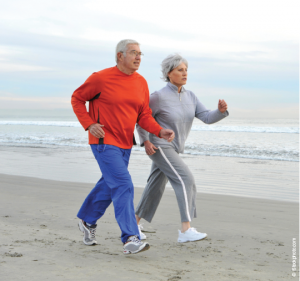Current data from the National Audit for Cardiac Rehabilitation (NACR) report that the average uptake of cardiac rehabilitation (CR), which includes exercise, is about 38%; ranging from 30% in patients following angioplasty to 68% for patients following bypass surgery.1 The NACR has highlighted numerous potential reasons for this lower than desired uptake, including the quality of local referral and patient recruitment processes, patient education and socio-cultural barriers to access.1 These problems are not exclusive to the exercise component of CR but affect the whole programme. This article will focus on the factors that CR professionals must consider in order to influence favourably the sustained longer-term participation in beneficial exercise for those patients who have taken up CR.
What is beneficial exercise?
 A prime question needs to be considered before furthering this discussion: what is meant by beneficial exercise? The benefits of exercise impact on all aspects of health – physiological, psychological and social. A study by Fox (1999) found that short bouts of any activity, even low-intensity activity that may not bring about a significant physiological risk factor change, if it is performed regularly, will provide psychological benefits to self-esteem and self-efficacy, and reductions in anxiety and depression.2 Angina patients engaging in regular walking on a similar premise to that expressed by Fox show significant reductions in a number of psychological parameters and symptoms, including anxiety and depression, frequency of angina, use of glyceryl trinitrate, and perceived physical limitations.3
A prime question needs to be considered before furthering this discussion: what is meant by beneficial exercise? The benefits of exercise impact on all aspects of health – physiological, psychological and social. A study by Fox (1999) found that short bouts of any activity, even low-intensity activity that may not bring about a significant physiological risk factor change, if it is performed regularly, will provide psychological benefits to self-esteem and self-efficacy, and reductions in anxiety and depression.2 Angina patients engaging in regular walking on a similar premise to that expressed by Fox show significant reductions in a number of psychological parameters and symptoms, including anxiety and depression, frequency of angina, use of glyceryl trinitrate, and perceived physical limitations.3
An important determinant and/or barrier to participation in physical activity is mental health and well-being.4 A beneficial and important first step in CR is therefore to encourage patients to be more active in their daily lives, especially those patients whose mental health has been affected by their diagnosis of cardiovascular disease. Longer-term participation, required to sustain the benefits, is reliant upon motivation directly linked to self-efficacy, mood, health beliefs and mental health.5 Best practice in CR would recommend the use of motivational interviewing techniques and cognitive behaviour strategies, which respect the states of behaviour and mental health noted above.6
Managing the message
 The minimum that a CR team should do, including volunteers and administration staff who regularly come into contact with patients, is to create a culture that respects that all patients hold different beliefs about their health and can be at very different stages of behaviour change. Common sense suggests that consistency in messaging from all staff is good practice, but it is important to remember that the same message can mean different things to different people. For some, this can certainly influence behaviour favourably but for others it may have the opposite effect. Good patient interaction and education sessions (both formal and informal) help the CR team to determine the variety of health beliefs that are held within a group of patients. Involving more than just the exercise staff in the exercise programme provides an opportunity for all staff to observe how patients respond psychologically and socially to physical activity, which can help highlight aspects of their psychological health and health beliefs that may be guarded when in a more formal education or counselling session. By using multidisciplinary team meetings, staff can then agree on what approaches they wish to take to support the behaviour change of those patients with the greatest need for overcoming barriers, support and encouragement.
The minimum that a CR team should do, including volunteers and administration staff who regularly come into contact with patients, is to create a culture that respects that all patients hold different beliefs about their health and can be at very different stages of behaviour change. Common sense suggests that consistency in messaging from all staff is good practice, but it is important to remember that the same message can mean different things to different people. For some, this can certainly influence behaviour favourably but for others it may have the opposite effect. Good patient interaction and education sessions (both formal and informal) help the CR team to determine the variety of health beliefs that are held within a group of patients. Involving more than just the exercise staff in the exercise programme provides an opportunity for all staff to observe how patients respond psychologically and socially to physical activity, which can help highlight aspects of their psychological health and health beliefs that may be guarded when in a more formal education or counselling session. By using multidisciplinary team meetings, staff can then agree on what approaches they wish to take to support the behaviour change of those patients with the greatest need for overcoming barriers, support and encouragement.
Most randomised controlled trials on the benefits of CR used to justify its provision have similar key features, including mortality as a key outcome and aerobic exercise training of moderate to vigorous intensity at least three times a week, and performed within structured periods of 20 to 60 minutes.7 The underpinning feature to this is that the total weekly caloric expenditure should exceed 1,000 kcals.8 When energy expenditure exceeds 1,000 kcals/week, key risk factors (lipids, blood pressure, body mass, blood glucose and aerobic endurance) are reduced.9 When 1,500 kcals/week is exceeded, not only are aerobic endurance and power significantly enhanced but so are arterial plaque stability and endothelial vasodilatory function.10
Tailoring fitness training to the patient
In the past decade, the benefits of strength training and interval training (short bouts of higher-intensity activity interspersed with periods of ‘active recovery’ or lower intensity) have been shown to be beneficial to low-capacity patients (those with heart failure and older patients), with benefits including enhanced physical functioning, quality of life, reduced symptoms and in some cases longer life.11,12 Many CR professionals think that simple activities of daily life are low intensity, but for a patient with a limited capacity, even walking slowly will require more than 50% of that patient’s aerobic power; a threshold associated with ‘fitness training’. Herein lies the fact that, for these patients, just being more active in day-to-day life could equate to fitness training. Thus, the advice we do give must be tailored and individualised.
Summary
A graded approach to introducing patients to the ‘behaviour of physical activity’ needs to be respected on an individual basis. The main aim is to guide gradual increases in the weekly frequency, intensity and duration of physical activity in keeping with both the patient’s psychological and physiological status. This can be achieved either
through more activity within patients’ daily lives, or in more formalised exercise
sessions, or more likely a combination of
the two. A clear and thorough assessment
of the patient’s psychological and physiological function, needs and constraints, followed by an agreed plan that is led by
the patient of his/her goals and progress (physical and psychologically), is vital to
the success of this behaviour we call
exercise.
References
1. National Audit of Cardiac Rehabilitation. Annual Statistical Report 2009. Available at www.cardiacrehabilitation.org.uk/nacr/docs/2009.pdf
2. Fox K. The influence of physical activity on mental well-being. Public Health Nutrition 1999;2(3a):411–18.
3. Lewin RJ, Furze G, Robinson J et al. A randomised controlled trial of a self-management plan for patients with newly diagnosed angina. Br J Gen Pract 2002;52(476):194–6, 199–201.
4. Turner SC, Bethell HJ, Evans JA, Goddard JR, Mullee MA. Patient characteristics and outcomes of cardiac rehabilitation. J Cardiopulm Rehabil 2002;22(4):253–60.
5. Buckley JP. Exercise on prescription activity for cardiovascular health. Butterworth-Heinemann, 1998.
ISBN: 978-0-7506-3288–1.
6. Britt E, Hudson SM, Blampied NM. Motivational interviewing in health settings: a review. Patient Education Counseling 2004;53:147–55.
7. Taylor RS, Brown A, Ebrahim S et al. Exercise-based rehabilitation for patients with coronary heart disease: systematic review and meta-analysis of randomized controlled trials. Am J Med 2004;116(10):682–92.
8. Hambrecht R, Niebauer J, Marburger C et al. Various intensities of leisure time physical activity in patients with coronary artery disease: effects on cardiorespiratory fitness and progression of coronary atherosclerotic lesions. J Am Coll Cardiol 1993;22(2):468–77.
9. Hardman AE, Stensel DJ. Physical activity and health: the evidence explained. Oxford: Routledge, 2009.
10. Linke A, Erbs S, Hambrecht R. Effects of exercise training upon endothelial function in patients with cardiovascular disease Front Biosci 2008;1(13):424–32.
11. Davies EJ, Moxham T, Rees K et al. Exercise based rehabilitation for heart failure. Cochrane Database of Systematic Reviews 2010.
12. Meyer K, Samek L, Schwaibold M et al. Interval training in patients with severe chronic heart failure: analysis and recommendations for exercise procedures. Med Sci Sports Exerc 1997;29(3):306–12.
